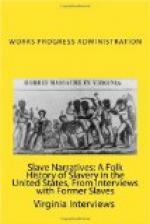“Mother was a field hand. She wasn’t real black. My father never did do much. He was a sort of a foreman. He rode around. He was lighter than I am. He was old man Pettus’ son. Old man Pettus had a great big farm—land! land! land! Wiley and Milton Roberts had farms between Dr. Palmer and old man Pettus’ farm. Mother originally belong to old man Pettus. He give Miss Sarah Palmer her place on the Augusta Road and his son the place on which his own home was. They was his white children. He had two. Mother was hired by her young mistress, Dr. Palmer’s wife, Miss Sarah. Father rode around, upheld by the old man Pettus. He never worked hard. I don’t know if old man Pettus raised grandma or not; he never grandpa. He was a Terral. He died when I was small. Grandpa was a field hand. He was the only colored man on the place allowed to have a dog. He was Dr. Palmer’s stock man. They raised their own stock; sheep, goats, cows, hogs, mules, and horses.
“None of us was ever sold that I know of. Mother had three boys and three girls. One sister died in infancy. One sister was married and remained in Georgia. Two of my brothers and one sister come to Arkansas. Mother brought us boys to a new country. Father got shot and died from the womb. He was a captain in the war. He was shot accidentally. Some of them was drinking and pranking with the guns. We lived on at Dr. Palmer’s place till 1866. That was our first year in Arkansas. That was nearly two years. We never was abused. My early life was very favorable.
“The quarters was houses built on each side of the road. Some set off in the field. They must have had stock law. We had pastures. The houses was joining the pasture. Mr. Pope had a sawmill on his place. The saw run perpendicularly up and down. He had a grist mill there too. I like to go to mill. It was dangerous for young boys. Mr. Pope’s farm joined us on one side. Oxen was used as team for heavy loads. Such a contrast in less than a century as trucks are in use now. I learned about oxen. They didn’t go fast ‘ceptin’ when they ran away. They would run at the sight of water in hot weather. They was dangerous if they saw the river and had to go down a steep bank, load or no load the way they went. If it was shallow they would wade but if it was deep they would swim unless the load was heavy enough to pull them down. Oxen was interesting to me always.
“Children didn’t stay in town like they do now. They was left to think more for themselves. They hardly ever got to go to town.
“We raised a pet pig. Nearly every year we raised a pet pig. When mother would be out that pig would get my supper in spite of all I could do. The pig was nearly as large as I was. I couldn’t do anything. We had a watermelon patch and sometimes sold Dr. Palmer melons. He let us have a melon patch and a cotton patch our own to work. Mother worked in moonlight and at odd times. They give that to her extra. We helped her work it. They give old people potato patches and let the children have goober rows. Land was plentiful. Dr. Palmer wasn’t stingy with his slaves—very liberal. He was a man willing to live and let live so far as I can know of him.




